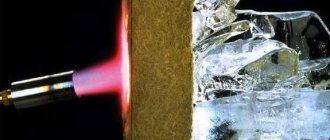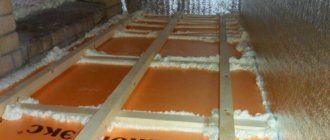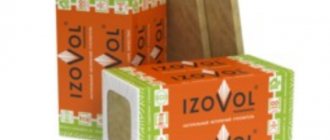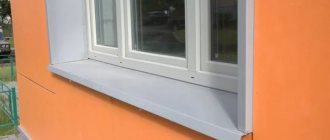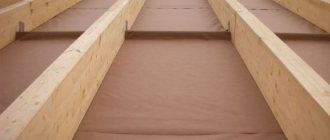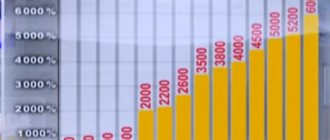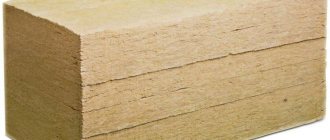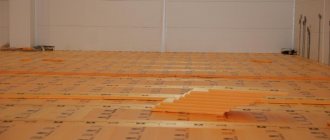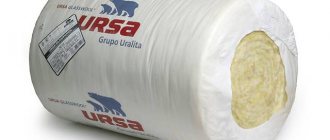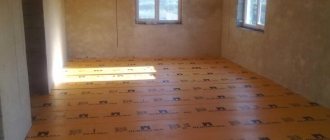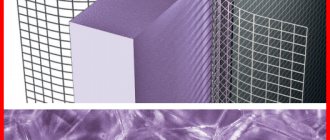What do we want to learn today? How much does 1 cube of ursa weigh, the weight of 1 m3 of ursa insulation such as mineral wool?
No problem, you can find out the number of kilograms or the number of tons at once, the mass (the weight of one cubic meter of URSA insulation, the weight of one cube of URSA thermal insulation, the weight of one cubic meter of thermal insulation material, the weight of 1 m3) is indicated in Table 1. If anyone is interested, you can run eyes a small text below, read some explanations.
How is the amount of substance, material, liquid or gas we need measured? Except for those cases when it is possible to reduce the calculation of the required quantity to the counting of goods, products, elements in pieces (piece counting), it is easiest for us to determine the required quantity based on volume and weight (mass). In everyday life, the most common unit of volume measurement for us is 1 liter. However, the number of liters suitable for household calculations is not always an applicable way to determine the volume for business activities. In addition, liters in our country have not become a generally accepted “production” and trade unit for measuring volume. One cubic meter, or in its abbreviated version - one cube, turned out to be a fairly convenient and popular unit of volume for practical use. We are used to measuring almost all substances, liquids, materials and even gases in cubic meters (mc). It's really convenient. After all, their costs, prices, rates, consumption rates, tariffs, supply contracts are almost always tied to cubic meters (cubes), and much less often to liters. No less important for practical activities is knowledge of not only the volume, but also the weight (mass) of the substance occupying this volume: in this case we are talking about how much 1 cubic meter of URSA thermal insulation weighs (1 cubic meter of ursa, 1 cubic meter of insulating material, 1 m3 of insulation ). Knowing the mass of mineral wool and the volume of heat-insulating material gives us a fairly complete idea of the quantity. Site visitors, when asking how much 1 cube of Ursa mineral wool weighs, often indicate specific units of mass in which they would like to know the answer to the question. As we noticed, most often they want to know the weight of 1 cube of ursa (1 cubic meter of insulation, 1 cubic meter of thermal insulation, 1 m3 of mineral wool) in kilograms (kg) or tons (t). Essentially, you need kg/m3 or t/m3. These are closely related units that define quantity. In principle, a fairly simple independent conversion of the mass of insulation from tons to kilograms and vice versa is possible: from kilograms to tons. However, as practice has shown, for most site visitors a more convenient option would be to immediately find out how many kilograms 1 cubic (1 m3) of ursa insulation weighs or how many tons 1 cube (1 m3) of ursa of mineral wool for thermal insulation weighs
, without converting kilograms into tons or back - the number of tons in kilograms per cubic meter (one cubic meter, one cubic meter, one m3).
Therefore, in Table 1 we indicated how much 1 cubic meter of thermal insulation weighs (1 cubic meter of mineral wool, 1 cubic meter of insulation) in kilograms (kg) and tons (t). Choose the table column that you need yourself. By the way, when we ask how much 1 cubic meter (1 m3) of URSA thermal insulation weighs, we mean the number of kilograms or the number of tons. However, from a physical point of view, we are interested in bulk density or specific gravity. The mass of a unit volume or the amount of substance placed in a unit volume is the bulk density of insulation or the specific gravity of thermal insulation. In this case, the volumetric density of URSA thermal insulation and the specific gravity of URSA.
The bulk density of mineral wool for thermal insulation and the specific gravity of Ursa insulation in physics are usually measured not in kg/m3 or in tons/m3, but in grams per cubic centimeter: g/cm3. Therefore, in Table 1, the specific gravity of URSA insulation and the density (synonyms) of mineral wool are indicated in grams per cubic centimeter (g/cm3)
Table 1. How much does 1 cube of ursa weigh, the weight of 1 m3 of ursa (mineral wool). Bulk density of URSA thermal insulation and specific gravity in g/cm3. How many kilograms are there in a cube of URSA insulation material, tons in 1 cubic meter of URSA insulation, kg in 1 cubic meter of mineral wool, tons in 1 m3.
Bulk density of Ursa miwata, specific gravity of URSA thermal insulation in Table 1.
Bulk density of URSA thermal insulation and specific gravity of URSA insulation, mineral wool
are given in Table 1 as additional information.
REVIEWS. How much does 1 cube of ursa weigh, the weight of 1 m3 of insulation. The number of kilograms in 1 cubic meter of URSA thermal insulation, the number of tons in 1 cubic meter of mineral wool, kg in 1 m3. Bulk density of URSA insulation, specific gravity.
About the weight and density of mineral wool boards using the example of Rockwool products
Rockwool slabs and mats are among the most popular on the market, so using their example it makes sense to trace the relationship between the weight and density of the final products. Most often, slabs are used to construct a thermal insulation layer:
- Rockwool Acoustic Butts - density 45 kg/m3;
- Rockwool Acoustic Butts - density 37 kg/m3;
- Light Butts Scandic - density 37 kg/m3.
The first version of slabs with parameters 1000x600x50 mm with a weight of up to 1.35 kg. The second one with similar dimensions weighs up to 1.1 kg, and the Scandic stove with the same parameters weighs only 0.75 kg. The example shows that the mass of insulation depends not only on density, but also on composition.
The weight of insulators based on mineral wool can differ radically when using combinations, for example, as in Rockwool Fire Butts foil slabs, the density of which is 110 kg per cubic meter with dimensions of 1000 × 600 × 30 mm and a weight of about 2 kg. The thickness of the insulator also matters. The same Light Butts Scandic with a density of 37 kg/m3, but with a thickness twice the above, will weigh about 1.5 kilograms.
In conclusion, it remains to be noted that the weight of the insulation is important in cases where it is necessary to install a layer of thermal insulation without loading the structure, for example, in attics, ceilings, and facade walls for decorative finishing. Meanwhile, light weight is not always an advantage. Lighter insulation is less dense, and this is not always exactly what is needed to create truly reliable and durable insulation.
Description and influence
Density is a value that is inversely proportional to the porosity of the insulation. Porous materials retain heat and create a kind of buffer. Therefore, the conclusion arises about how density affects: the higher the specific gravity, the less thermal insulation properties the insulator has.
A good example
For example, birch timber - 500-770 kg/m3, basalt fiber - 50-200 kg/m3. And the thermal conductivity coefficient of birch is 0.15 W with the same fiber index of 0.03-0.05 W. Thus, porous mineral insulation retains heat almost 5 times more efficiently than denser wooden beams.
It is precisely because of their specific gravity that even thick, reliable walls do not always provide good thermal protection. But a thin layer of insulation can correct this problem. In addition, low specific gravity gives less load on structures: cellular concrete with a low thermal conductivity coefficient of 0.1 W is not suitable for insulating thin walls and frame buildings since its density is almost 400 kg/m3.
Density provides resistance to mechanical stress, so insulators with low specific gravity require a protective layer. Such materials include penoizol, polystyrene foam and penoplex, as well as mineral wool.
What it is?
The density of mineral wool is the number of fibers of the material per 1 m³. The indicator, depending on the material and brand used for the manufacture of mineral wool, will be in the range of 30-220 kg per m³. A number of properties that characterize it:
- The ability to preserve its original form.
- Ability to withstand static and dynamic loads.
- Compression resistance, that is, the ability to withstand mechanical influence.
- Method, place of application. How exactly the mineral wool will be installed greatly influences the choice.
Naturally, the denser the material, the more raw materials are used in production, and this affects the price.
Stamps
At the moment there is the following classification:
- P-75 is an insulation material that is used for horizontal surfaces that are unloaded, that is, 1- or 2-story buildings. This material has the lowest density.
- P-125 - this can be used for floors and ceilings; it is successfully used in insulating frame structures. At the same time, the weight of the structure should be lightweight. The density is low, so this brand is not able to withstand loads.
- P-175 are rigid slabs, they can be successfully used for screeds.
- PPZh-200 – slabs of increased rigidity. Their weight and density are maximum. In addition to insulation, it increases the fire-resistant properties of the structure.
Density does not depend on shape and thickness
Note! It is the density of glass, slag, and stone wool that is the indicator that influences resistance to deformation under its own weight. It prevents the material from bending under pressure and additional loads.
Compacting the slab has no effect on:
- Vapor permeability.
- Noise absorption.
- Thermal insulation properties.
- The thickness of the material, regardless of the form of its release (rolls, slabs).
To determine density, the material weight of 1 m³ is used. When choosing, you don’t always need to buy the densest cotton wool. To make the right choice, you need to take into account the characteristics of the room in which it will be installed.
Life time
The material can withstand temperatures up to +1114 degrees without reaching the melting point. For this reason, basalt insulation can be used in difficult conditions, to insulate devices that operate at elevated temperatures. This factor does not affect the duration of use of the material.
The service life of basalt thermal insulation is 40-50 years. At the same time, there is a requirement for the operation of buildings, according to which each house must undergo an energy audit every 25 years. If the material loses its heat-saving qualities, the insulation is re-installed.
offers basalt insulation with the necessary parameters. We also sell other materials for thermal insulation from various materials - extruded polystyrene foam, stone wool, quartz-based mineral insulation, PIR boards. For additional advice, call our manager by phone.
Manufacturers and types
However, modern materials, thanks to the latest technologies, can have different densities despite the fact that they are made from exactly the same raw materials.
Fiber raw materials
Basalt wool has an average value of 50-200 kg/m3 - the range is wide. The maximum value belongs to options intended for floors and roofs.
Thus, TechnoNikol Galatel basalt slabs have a specific gravity of 195 kg/m3. Dahrok basalt wool from Rockwool, 190 kg/m3, is intended for insulation under roll roofing. Knauf Insulation HTB basalt fiber with a low density of 35 kg/m3 is intended for frame structures and prefabricated buildings. TechnoNikol Rocklight mineral wool in 30-40 kg/m3 is a lightweight insulation option, and the same Knauff company produces Knauff NTV in a density variation of 150 kg/m3.
Foam materials
The density of foam plastic is about 100-150 kg/m3 - the densest slabs are needed for finishing the roof or floors. Manufacturers clearly divide foam boards by area of application, when the specific gravity changes accordingly. Extruded polystyrene foam at 28-35 kg/m3 is one of the lightest materials and the most heat-insulating.
For example, TechnoNikol Carbon Sand with a rating of 28 kg/m3 is used for sandwich panels, and TechnoNikol Carbon Prof with a rating of 30-35 kg/m3 is applicable for insulating walls and load-bearing structures. Plates from the same manufacturer with a density of 50-60 kg/m3 are used for road construction. Penoplex Wall has a differentiated density: 25 kg/m3 - for insulating vertical structures, 47 kg/m3 - for road construction.
Using wool of different densities for insulation
The choice of insulation according to the indicator under consideration depends on the place of its use. It is not always necessary to overpay in order to get the desired result. Most often, the facade, walls, roof and floor are insulated. These are the options that are worth considering.
Regardless of density, the material must be protected from moisture
Facade
When selecting insulation for a facade, you need to pay attention to the mass and density of mineral wool. For most buildings, weighting is very undesirable. It is also worth paying attention to the possibility of subsequent finishing, because this indicator also affects this. So:
- If the facade is equipped with a ventilated one, then a sufficient density is 45-100 kg m³. Here the cotton wool is laid into the sheathing and there will be virtually no stress. The main tasks for this type are to maintain its shape and not sag under its own weight, and the indicated indicator is enough for this.
- If the facade is to be plastered over insulation, then the density should be above 100 kg m³, optimally from 145 to 165. This will allow the use of any types of plaster mixtures, including bark beetle, barenkom and even mosaics. Since this mineral wool will have to withstand heavy loads during installation, it must be securely fastened; for this, a system with dowels is used in combination with adhesive fastening.
Wall insulation
In this case, the selection is made based on ease of installation, that is, the density should be at least 30-45 kg m³. In this case, you need to insulate from the inside; MDF boards or drywall should be screwed onto the material on top. In order to mount such mineral wool, you need a lathing; rolls or sheets are placed in it.
What should be the density of insulation in a winter jacket?
Insulation density in winter
clothes
Insulation density
usually indicated on the label
of winter
clothing - these are numbers from 60 to 350 (grams). The higher the number, the lower temperatures the product can withstand.
Interesting materials:
How to find out why it is cold in the apartment? How to find out how long to drill a well? How to find out how many kilowatts are in the engine? How to find out how many amperes it consumes? How to find out how much electricity your computer consumes? How to enable USB debugging if the screen is broken? How to recover contacts from a phone if it won’t turn on? How to restore contacts from a phone if it's broken? How to restore mail to mail ru if you don’t remember anything? How to unscrew a screw if it turns?
Main characteristics of basalt insulation
Rock wool is often used as insulation for homes. The material is easy to install and is resistant to fire and cold.
The following properties of basalt wool insulation can be distinguished:
- low thermal conductivity;
- the material does not absorb moisture;
- ability to pass steam;
- fire resistance;
- high sound insulation.
The advantageous characteristics of basalt insulation classify it as one of the most reliable thermal insulation materials. It is characterized by high density and strength, long service life.
Basalt insulation is used in rooms with high humidity, such as baths or saunas. It can be used for ventilated or suspended facades. It can even be used in ship structures and premises, including ship cabins. This is an indispensable material for fire protection of building structures and ventilation pipes.
Thermal conductivity
The fibers in the material are arranged randomly, which creates an airy structure. The result is good thermal insulation of various surfaces. The thermal conductivity of basalt insulation is in the range of 0.032-0.048 W/mK. High-quality thermal insulation is created thanks to a large number of air layers. Simple or extruded polystyrene foam and foam rubber have similar properties.
For comparison, a mat with a thickness of 10 cm and a density of up to 100 kg/cubic. m. provides a similar degree of heat retention as a brick wall with a thickness of 117 cm. A wooden building with similar parameters will reach a wall thickness of 25 cm.
Thickness and width
The thickness and width of basalt wool depend on the form of release. The material is produced in the following versions:
| Plates | Standard sizes are width 600 mm, length 1000 or 1200 mm. The thickness parameter is different - 20.50 100 mm |
| Rolls | Common sizes - 50x1000x4000, 200x1000x6000, 200x1000x3000, 200x1000x4750, 200x1200x2000 mm |
| Cylinders and mats | Dimensions depend entirely on the company producing the product |
Manufacturers also produce basalt chips. This is the waste that appears after cutting rolls or slabs. It is used to insulate only horizontal surfaces.
